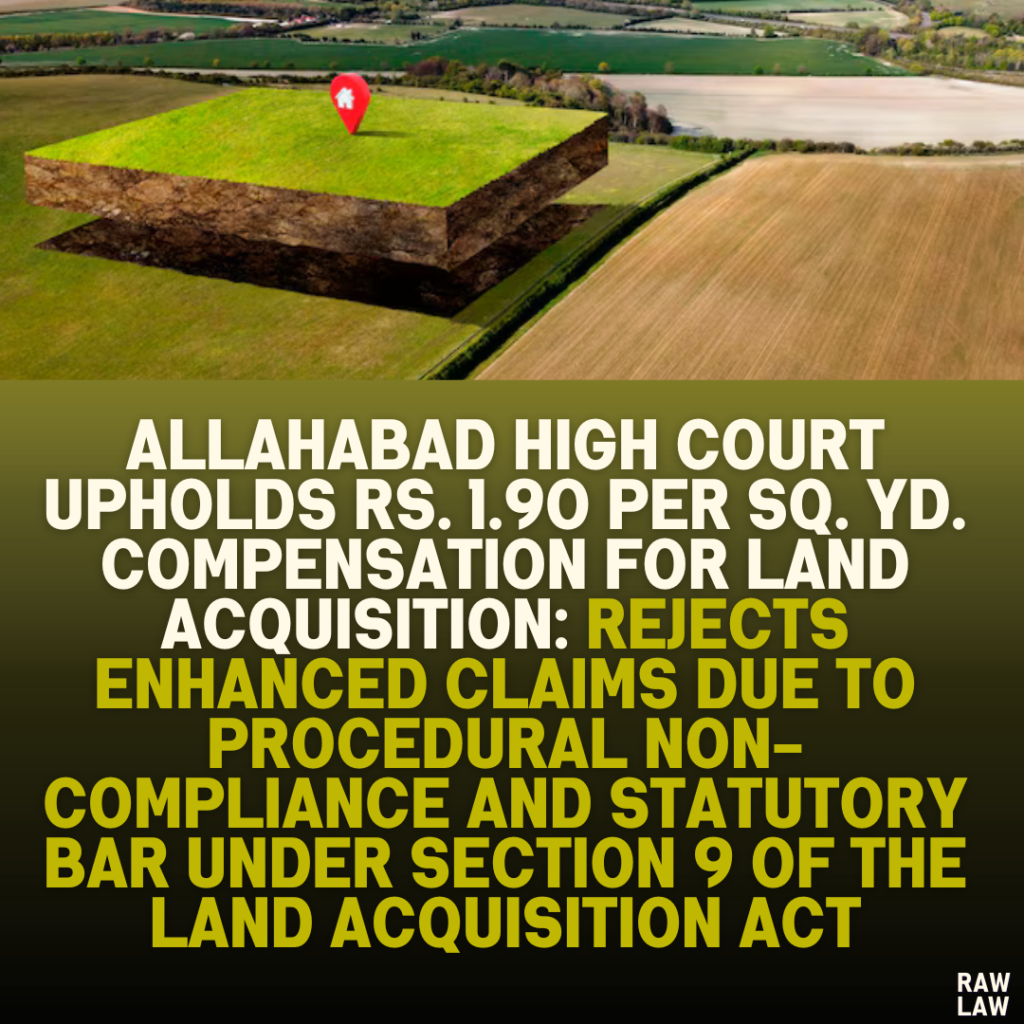Court’s Decision:
The Allahabad High Court dismissed appeals filed by tenure holders seeking enhanced compensation for land acquired in Ghaziabad. It upheld the original award of Rs. 1.90 per square yard, determined by the Special Land Acquisition Officer (SLAO). The court emphasized that the tenure holders’ failure to file claims under Section 9 of the Land Acquisition Act, 1894, barred them from seeking enhanced compensation under Section 25 of the Act. Additionally, the court allowed appeals filed by CPWD and the State of Uttar Pradesh challenging the enhanced compensation granted by the Reference Court.
Facts:
- Land Acquisition Background:
- The State of Uttar Pradesh acquired land in village Raispur, Ghaziabad, through notifications issued in 1963-65 under Sections 4 and 6 of the Land Acquisition Act, 1894.
- The SLAO awarded compensation at Rs. 1.90 per square yard in 1986.
- Challenges by Landowners:
- Dissatisfied with the SLAO’s award, landowners filed Land Acquisition References (LARs), resulting in an enhancement to Rs. 8 per square yard by the Reference Court in 1991.
- Subsequent Appeals:
- In one case (“Ran Singh”), the Allahabad High Court further enhanced the compensation to Rs. 84 per square yard, which became final after the Supreme Court dismissed the State’s appeals due to delay.
- Role of CPWD and UOI:
- CPWD and UOI were impleaded as parties in the appeals and contested the enhanced compensation, arguing that they were not parties to the “Ran Singh” case.
Issues:
- Applicability of “Ran Singh”: Whether CPWD and UOI, as non-parties in earlier proceedings, were bound by the enhanced compensation of Rs. 84 per square yard.
- Entitlement to Higher Compensation: Whether tenure holders who did not file claims under Section 9 of the Land Acquisition Act could seek compensation exceeding the SLAO’s award.
Petitioner’s Arguments:
- Uniform Application of “Ran Singh”:
- Tenure holders argued that the enhanced compensation in “Ran Singh” should apply to all similarly situated landowners.
- Finality of Previous Decision:
- The petitioners contended that CPWD and UOI were barred from contesting the compensation determined in “Ran Singh,” as the Supreme Court dismissed the appeals.
Respondent’s Arguments:
- Procedural Non-Compliance:
- CPWD and UOI highlighted that the tenure holders had not filed claims under Section 9 of the Land Acquisition Act, barring them from seeking enhanced compensation under Section 25.
- Distinction from “Ran Singh”:
- They argued that “Ran Singh” involved different factual and procedural circumstances, including acquisition by the Ghaziabad Development Authority for a distinct purpose.
- Doctrine of Merger:
- They asserted that the dismissal of appeals by the Supreme Court on procedural grounds (delay) did not constitute a decision on merits and, therefore, did not preclude their objections.
Analysis of the Law:
The court undertook a detailed analysis of the relevant provisions:
- Section 9 of the Land Acquisition Act:
- Requires landowners to file claims specifying the compensation sought.
- Failure to file such claims restricts their entitlement to the SLAO’s award.
- Section 25 of the Land Acquisition Act:
- Limits the court’s power to award compensation exceeding the claimant’s demand under Section 9.
- Bars enhancement beyond the SLAO’s award if no claim is filed.
Precedent Analysis:
The court relied on established precedents:
- Dadoo Yogendranath Singh v. Collector, Seoni (1977):
- Held that courts cannot award compensation exceeding the SLAO’s determination if no claims are filed.
- Gobardhan Mahto v. State of Bihar (1979):
- Reinforced that non-filing of claims under Section 9 restricts compensation awards.
- Dilawarsab Babusab Mullasab v. SLAO (1975):
- Clarified that Section 25 bars higher compensation for non-claimants.
Court’s Reasoning:
- Distinguishing “Ran Singh”:
- The court found that “Ran Singh” involved distinct circumstances, including acquisition by the Ghaziabad Development Authority, different notifications, and higher commercial value of the land.
- No Doctrine of Merger:
- The court rejected the argument that the dismissal of appeals by the Supreme Court merged the “Ran Singh” decision into binding law for all connected cases.
- Statutory Bar under Section 25:
- The court concluded that the tenure holders’ failure to file claims under Section 9 triggered the statutory bar under Section 25, precluding any enhancement beyond Rs. 1.90 per square yard.
Conclusion:
- Dismissal of Tenure Holders’ Appeals:
- The court dismissed the appeals seeking higher compensation, holding that they were barred by law.
- Allowance of CPWD and State Appeals:
- The court allowed the appeals filed by CPWD and the State, setting aside the Reference Court’s enhancement to Rs. 8 per square yard.
Implications:
This judgment underscores the importance of procedural compliance under the Land Acquisition Act. It limits the scope of enhanced compensation for tenure holders who fail to adhere to statutory requirements, reaffirming the binding nature of procedural safeguards in land acquisition matters.



